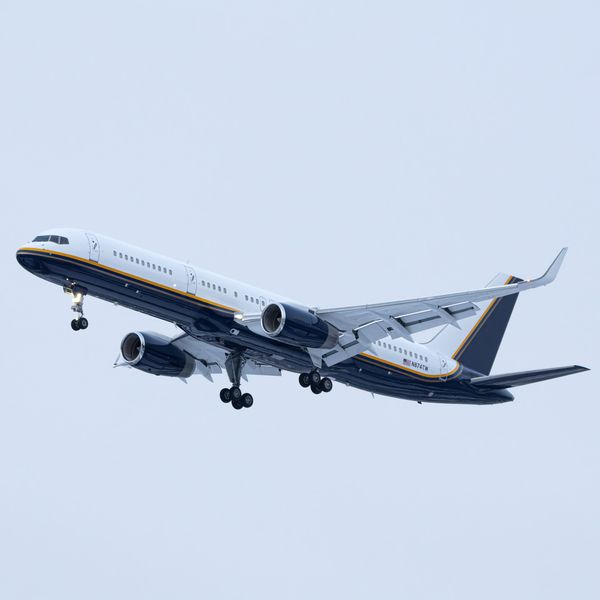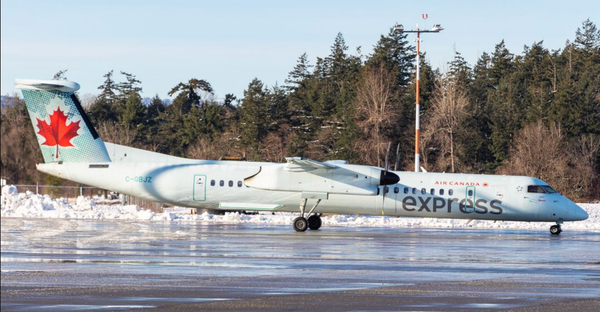While aviation safety had its ups and downs, it surely has improved vastly over the decades. However, some aircraft are remembered for their infamous history of frequent crashes, including the McDonnell Douglas DC-10. So why did the DC-10 have such an unfortunate name tag on its tail? Let's find out.
A New Widebody Aircraft
The DC-10 was born as American Airlines requested to develop a smaller, single-floor twin-engine aircraft than the Double-Decker Boeing 747 to fly shorter routes with fewer needs. The request had the following conditions:
1. An engine that produces 40,000-pound feet of torque
2. 250 seats (with a pitch of 36 inches)
3. 250 pounds of baggage per passenger and another 5000 pounds of cargo
4. At least flies a distance of 2100 miles
However, the technology at the time limited the range of a twin-engine aircraft significantly. Thus, Boeing, McDonnell Douglas, and Lockheed Martin could not keep the above conditions coming to fruition. This is where the design concept of a three-engine aircraft was devised, the trijets.
McDonnell Douglas introduced the DC-10, and the first commercial flight of the DC-10 was made by American Airlines on August 5th, 1971. Lockheed Martin later introduced the L-1011 amid development delays, and began commercial service with Eastern Air Lines on April 26th, 1972.
Design Faults
However, the DC-10 experienced several accidents from the start of its service. On June 12th, 1972, less than a year after its first commercial flight, a DC-10 had its cargo door ripped off during a flight. American Airlines Flight 96 departed Detroit bound for Buffalo, when the cargo door was blown off the aircraft over Canada.
Fortunately, all 67 crew and passengers survived, and the DC-10 could make it back to Detroit safely despite the crew nearly unable to control the aircraft. The problem was that the locks for the cargo doors were faulty, leading to their unlocking.
The DC-10, unlike other airplanes at the time, had its cargo doors open outwards rather than inwards into the aircraft. This meant more space for cargo inside the cargo bay, but it also had to withstand tremendous amounts of air pressure while at cruising altitude. The faulty locks failed to secure the cargo doors in flight, and caused the whole door to be blown off mid-flight.
McDonnell Douglas sent out safety recommendations and advisories following Flight 96. McDonnell also added relief vents to the cabin floors to relieve pressure from the difference in air pressure between the cargo bay area and the passenger cabin area.
However, these measures consisted of merely adding a window to the cargo door to ensure safe lockage of the locking mechanism. It was not even properly communicated to ground staff such that some didn't even know about the addition of the window. This would prove crucial two years later, in 1974.
On March 3rd, 1974, 5 days before the grand opening of Charles de Gaulle Airport in Paris, Turkish Airlines Flight 981 was heading to London Heathrow Airport from Paris Orly Airport.
This was usually an empty flight, but BEA (merged later with BOAC to form today's British Airways) had a strike that caused passengers to be stranded at Paris Orly Airport, so those passengers were put on this Turkish flight.
However, as the aircraft took off and was climbing to cruising altitude at 10,000 feet, the cargo door blew off the aircraft making a huge hole in the cabin floor in the process. Some of the debris even damaged hydraulic lines, making the aircraft almost uncontrollable. The trijet crashed into a French forest, killing all 346 people on board.
Investigators found that ground personnel were unfamiliar with the English written instructions and the use of the window to determine the correct locking. Also, the relief vents were not large enough to relieve pressure quickly during an explosive decompression.
Ultimately, the failure to spot a malfunction in the cargo door and the failure of the cabin floor after cargo door separation caused significant structural damage to the aircraft, damaging the control methods in the process. The aircraft could not recover from its upset attitude and eventually crashed into the forest.
Numerous Accidents
After the two infamous accidents, McDonnell Douglas provided airlines and operators with major safety bulletins, and the DC-10 seemed to become back a safe plane to fly on.
However, this time, the operators themselves started causing major accidents with the DC-10, starting with ONA Flight 032, which ran into some unlucky seagulls while taking off.
The aircraft burst through airport perimeter fences and caught fire, and while all passengers survived, the aircraft was written off. Other hull-loss accidents included Saudia Flight 5130 and Korean Air Flight 084. However, much more serious accidents also happened.
On May 25th, 1979, American Airlines Flight 191 crashed while taking off from Chicago O'Hare Airport. Engine #1, the engine under the aircraft's left wing, detached during the takeoff roll and damaged control surfaces.
This made the aircraft uncontrollable, and eventually, the DC-10 crashed into a trailer park near the runway, killing another two people. This crash was not due to the design of the DC-10, but rather a maintenance failure.
5 months later, on October 31st, Western Airlines Flight 2605 crashed into ground construction equipment on the runway while landing in Mexico City, killing 72 people out of 88 on board. This was caused by improperly following landing guides at the airport at the time.
Less than a month later, on November 28th, Air New Zealand Flight 901 crashed into an iceberg while performing a sightseeing flight in Antarctica. All 257 people on board died, and the crash was caused due to visual confusion and unstable flight planning by the flight crew.
There were several other major fatal accidents involving the DC-10. Still, almost every crash was caused due to pilot error or improper maintenance (the most famous case being the crash of United Airlines Flight 232). However, the already tainted reputation of the DC-10 only deteriorated due to these crashes that were unrelated to aircraft design.
Still a Relatively Safe Aircraft
Still, from the perspective of a regular passenger, the DC-10 was a safe plane to fly on. The only issues that were caused after the crash of Turkish Airlines Flight 981 were generally pilot error and maintenance errors.
Statistically, the DC-10 was even safer than the Boeing 747 and Airbus A300 in terms of fatalities per aircraft sold. The DC-10 was even praised by pilots for its stable maneuverability, which continued on to the MD-11, which was largely based on the DC-10.
The DC-10 ended its passenger carrier career successively in 2014 by Biman Bangladesh Airlines, as the aircraft type is considerably aged nowadays. Today, the DC-10 continues to be operated extensively by the U.S. Air Force in the form of the KC-10, an aerial tanker.
These tankers are expected to be replaced by KC-46 aircraft, which are based on newer Boeing 767s. Besides military operations, 6 DC-10s continue to be operated by civilian operators as cargo aircraft.
First Airbus A321XLR Arrives in Delhi to Launch Landmark Athens Route » NTSB Scrutinizes FAA NOTAM Logic Following Fatal MD 530F Canyon Crash » Air Canada Doubles Down on Regional Strength with Major PAL Airlines Expansion »
Comments (1)
 Jim
The title is a little unfair. Only one crash was attributable to the aircraft manufacturer and it was the Turkish Air incident. The rest were maintenance short cuts and pilot error. Were you even born during that era??
Jim
The title is a little unfair. Only one crash was attributable to the aircraft manufacturer and it was the Turkish Air incident. The rest were maintenance short cuts and pilot error. Were you even born during that era??
Add Your Comment
SHARE
TAGS
STORIES DC-10Flight 981Flight 191Flight 96American AirlinesAAMcDonnell DouglasBoeingL-1011LockheedLockheed MartinRECENTLY PUBLISHED
 This Week in Aviation: The 10 Stories That Mattered Most
From major airline developments to aircraft updates and industry shifts, this weekly recap highlights the ten most-read aviation stories from the week of January 04.
INFORMATIONAL
READ MORE »
This Week in Aviation: The 10 Stories That Mattered Most
From major airline developments to aircraft updates and industry shifts, this weekly recap highlights the ten most-read aviation stories from the week of January 04.
INFORMATIONAL
READ MORE »
 NTSB Scrutinizes FAA NOTAM Logic Following Fatal MD 530F Canyon Crash
One week after a private helicopter plummeted into the rugged depths of Telegraph Canyon, the aviation community is reeling not only from the loss of four lives but from the glaring systemic failures it has unearthed.
NEWS
READ MORE »
NTSB Scrutinizes FAA NOTAM Logic Following Fatal MD 530F Canyon Crash
One week after a private helicopter plummeted into the rugged depths of Telegraph Canyon, the aviation community is reeling not only from the loss of four lives but from the glaring systemic failures it has unearthed.
NEWS
READ MORE »
 Air Canada Doubles Down on Regional Strength with Major PAL Airlines Expansion
In a strategic move to fortify its presence in Eastern Canada, Air Canada has officially announced its intent to significantly expand and extend its commercial partnership with PAL Airlines. As of January 8, 2026, the two carriers have signed a Letter of Intent (LOI) that not only secures regional connectivity for the next decade but also introduces a substantial fleet expansion to meet rising demand in Québec and the Maritimes.
NEWS
READ MORE »
Air Canada Doubles Down on Regional Strength with Major PAL Airlines Expansion
In a strategic move to fortify its presence in Eastern Canada, Air Canada has officially announced its intent to significantly expand and extend its commercial partnership with PAL Airlines. As of January 8, 2026, the two carriers have signed a Letter of Intent (LOI) that not only secures regional connectivity for the next decade but also introduces a substantial fleet expansion to meet rising demand in Québec and the Maritimes.
NEWS
READ MORE »



